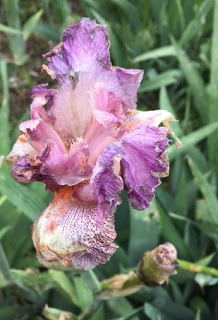 I've worried myself to distraction, this past month, concerned about the true costs of our April hailstorm on the garden. The loss of a year's worth of irises, peonies, and non-remonant roses is disappointment enough, but what of other garden inhabitants? In all the years I've gardened before now, I hadn't experienced hail that struck at the peak of spring, just as the garden year was beginning. I knew that roses and irises and peonies would survive decrepit and tired, building sugars from damaged factories until they were reborn next year, but what about other plants? If I grow tired of shredded iris leaves, I can always cut them off and force a rebirth, but gardens contain other lives that need to persist beyond a single cycle.
I've worried myself to distraction, this past month, concerned about the true costs of our April hailstorm on the garden. The loss of a year's worth of irises, peonies, and non-remonant roses is disappointment enough, but what of other garden inhabitants? In all the years I've gardened before now, I hadn't experienced hail that struck at the peak of spring, just as the garden year was beginning. I knew that roses and irises and peonies would survive decrepit and tired, building sugars from damaged factories until they were reborn next year, but what about other plants? If I grow tired of shredded iris leaves, I can always cut them off and force a rebirth, but gardens contain other lives that need to persist beyond a single cycle. Foremost, I wondered, what would become of the trees, the eternal trees, pummeled just as they opened their leaves, an entire year of stored energy wasted in seconds? Garden experts wrote fleetingly about possible regrowth on trees and other plants, regrowth that seemed too dependent on this condition or that condition, but I could find little documentation for my comfort. I wondered how the trees could possibly know if there was enough time left in the summer to try again or whether it would be better to save their resources for next spring? But I offer these pictures, captured one month after the hailstorm, as encouragement to those searching after me. For myself, they are lesson again that life can be both fragile and resilient in the same moment.
Foremost, I wondered, what would become of the trees, the eternal trees, pummeled just as they opened their leaves, an entire year of stored energy wasted in seconds? Garden experts wrote fleetingly about possible regrowth on trees and other plants, regrowth that seemed too dependent on this condition or that condition, but I could find little documentation for my comfort. I wondered how the trees could possibly know if there was enough time left in the summer to try again or whether it would be better to save their resources for next spring? But I offer these pictures, captured one month after the hailstorm, as encouragement to those searching after me. For myself, they are lesson again that life can be both fragile and resilient in the same moment.
The first two photos above are of new growth on two different Maples in my yard, the first an "October Glory" Red Maple, the second a Paperbark Maple. Both display their damage and regrowth at the same time, as do most of my trees that were so foolish as to get an early start on spring, hanging on to damaged leaves for sparse nourishment, but rebuilding with a vengeance. The third photo is a Redbud, an understory tree, also exhibiting torn and shiny new leaves on the same branches. Together, they are all evidence that this year is not a total loss, for me or for the trees.
In these lessons about hail, I also learned something about Darwinism and survival of the fittest. The least damaged trees of all in my garden were the trees that are traditional Kansas natives. My oaks, walnuts, and cottonwoods are all seemingly untouched, the first two because they kept their buds tight until well after the hailstorm and the latter because it seems that the bouncing poplar-like leaves of the cottonwood either dodged the hail stones or turned aside at the slightest touch, nimble as ninjas in the wind. There are many lessons here that the Homo-sapiens-introduced maples can learn from. The particular Homo sapiens also known as ProfessorRoush now understands again that despair is fleeting and hope is eternal.



































